Chariot › Charvaka › Prehistoric Hunter-gatherer Societies » Origins and History
Articles and Definitions › Contents
- Chariot › Origins
- Charvaka › Origins
- Prehistoric Hunter-gatherer Societies › Origins
Ancient civilizations › Historical places, and their characters
Chariot › Origins
Definition and Origins
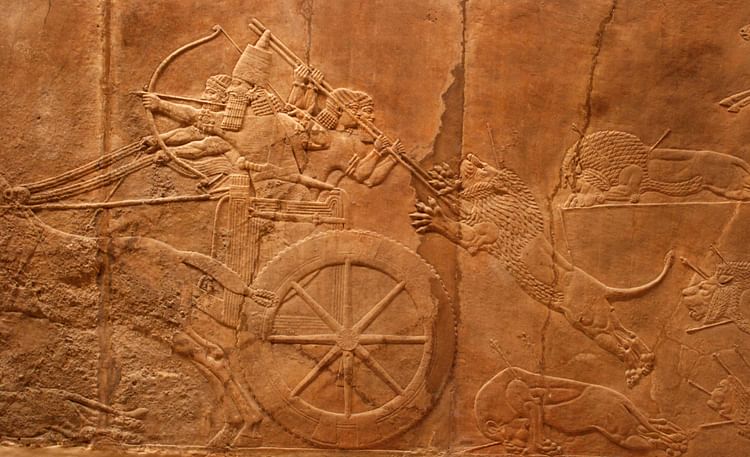
The chariot was a light vehicle, usually on two wheels, drawn by one or more horses, often carrying two standing persons, a driver and a fighter using bow-and-arrow or javelins. The chariot was the supreme military weapon in Eurasia roughly from 1700 BCE to 500 BCE but was also used for hunting purposes and in sporting contests such as the Olympic Games and in the Roman Circus Maximus.
Horses were not used for transport, ploughing, warfare or any other practical human activity until quite late in history, and the chariot was the first such application. Donkeys and other animals were preferred in early civilizations.
THE HORSE
The horse's main ecological niche was the Eurasian steppe; a very wide (4,800 km) and narrow (800 km on average) strip of grassland running roughly from Hungary to China, encompasing parts of what today is Ukrania, southern Russia, Kazakhstan, Uzbekistan, Turkmenistan, Kyrgyztan, Tajikistan and Mongolia. For most of ancient history, the steppe --which means “wasteland” in Russian-- was the home of nomadic societies whose economy was based on herding, complemented by hunting and, to a much lesser degree, sporadic, itinerant agriculture. No cities or settled communities existed in the steppe, save a very few spots.
Steppe dwellers domesticated the horse for the purpose of breeding it for food like sheep and other animals already domesticated. That process is unfortunately poorly understood, and it occurred sometime before 2500 BCE. The wheel, an invention imported from the civilized Middle East, had arrived in the steppe around 3100 BCE. The invention of the chariot in the steppe - perhaps originally meant as an improved tool for hunting - occurred roughly by 2000 BCE, probably in the area just east of the southern Ural mountains, where the oldest chariots have been unearthed. The word for horse appears just around this date for the first time in Mesopotamia, when an increase in north-south trade through Iran is attested.
ARROWS AND JAVELINS WERE THE MAIN WEAPONS USED BY THE FIGHTER ON BOARD, WHILE A SECOND PERSON DROVE THE CHARIOT.
INVENTION OF THE CHARIOT
The chariot then became a moving platform from which soldiers could shoot at enemies. Arrows and javelins were the main weapons used by the fighter on board, while a second person drove the chariot. The tactic was to move constantly, in and out of the battle, shooting from a distance.
There is no clear explanation as to why humans invented the chariot first, before riding the horse directly, which seem more straight-forward to us. A chariot was obviously more expensive than the horse alone, and chariots could not enter or properly manoeuver in landscapes where a mounted horse can, such as hills, marshes or forests. We know people tried mounting horses very early, since we have found drawings depicting it, but those seem rare experiments that did not seem to work. The most common scholarly suggestion is that horses at that time were weaker than in the present, unsuitable for supportingng a man and only after a very long period of constant, selective breeding, did a stronger horse come into being. Horses started consistently to be mounted roughly a millenium and a half after the chariot was invented.
The “compound bow”, invented sometime during the second millenium BCE, was the final ingredient for the rise of a deadly ensemble. Bow and arrow were much older, and the innovation of the compound bow was the use of two types of materials, inside and outside the bow, which gave it considerably more power. Compound bows were able to accurately hit a target 300 m away, and penetrate an armour 100 m away. It was the preferred weapon of charioteers and later horseback riding societies.Its power is reflected in the fact that these bows were last used in war as recently as the 19th century CE by the Chinese, well into the fire arms age.

Alabaster Panel from the Central Palace of Tiglath-pileser III
We have scarce knowledge of what happened with the communities in the steppe once the chariot was invented. We can assume that war intensified - and some evidence about it does exist -, and those who first or better grasped the new invention stormed their neighbours, sizing valuable hunting and pasturing land rights. We truly understand the impact of the chariot only when this new form of warfare came out of the steppes and into the settled, agricultural, civilized lands.
CHARIOTEERS & WARFARE
The first reference to charioteers in the civilized world comes from Syria around 1800 BCE. Over the course of the next four centuries, chariots advanced into civilization, either by direct migration of steppe people or by diffusion, and it quickly came to be the preferred elite weapon.
Hittites established their first kingdom with the help of chariots c. 1700 BCE, and thereafter used them intensely; Hurrians, from somewhere near the Caucasus, penetrated in the Middle East and carved a kingdom for themselves that was to play an important role in that region, Mitanni, around 1500 BCE; Egypt ’s north was taken by charioteers called Hyksos c.1650 BCE, who established their own dynasties; in China the first dynasty appeared, the Shang (starting c. 1600 BCE), with an aristocracy of charioteers; Mycenaeans adopted the chariot in Greece, which likely helped them invade their more sophisticated Minoan neighbours (c. 1400 BCE); tribes called Kassites appeared driving chariots from Iran and took Babylonia, establishing their own dyansty (c. 1570 BCE), which was to last four centuries; and the steppe dwelling Aryans, charioteers as well, from c. 1500 BCE migrated south to what today is Iran, Pakistan and India, profoundly influencing the local culture, particularly establishing the basis for Hinduism. The famous king Darius the Great of the much later Persian empire would proudly state his Aryan descent for good reason.

Hittite War Chariot
Everywhere, in Europe, the Middle East, India and China, all rulers, from petty chiefs to great pharaohs, took the chariot as their master weapon. They started depicting themselves riding chariots, waging wars in chariots, including chariots and horses in their tombs as symbols of power, and so on. Their surrounding aristocracy of course followed suit, so the elite forces in every polity came to be charioteers. The horse came to be a valuable military asset, no longer a food source. Horse breeding became key for these states, and all powerful kings aspired to have the proper stables to supply their armies with chariots;imports from the steppes, though, long remained their major source.
The most famous chariot battle was that of Kadesh (1294 BCE), fought between the two super powers of the time, Egypt and Hatti (Hittites), where some 50 chariots are presumed to have participated for each side. The small number of chariots compared to infantry troops is a good indicator of how effective the chariot was: in China the ratio was up to 25 infantry soldiers per chariot.
DECLINE IN USE
The use of the chariot declined very slowly, starting around 500 BCE (and yet, in some parts of Europe the technology was just arriving at that time). First and probably foremost, because horseback riding was developed in the steppes, and slowly but surely replaced the need for chariots. The first known forces mounting horses were those of the Scynthians, steppe people who in the 7th century BCE attacked the Assyrian empire on horseback. Second, because infantry, formerly helpless against chariots, became more sophisticated due to the expanding use of iron weapons (from c. 1200 BCE onwards), and to new tactics in the form of phalanx formations. Fighting the invading Romans, the Celts were probably the last people who used chariots extensively, until around the 4th century CE.
Charvaka › Origins
Definition and Origins

The Charvaka school was a philosophical movement in India that rejected the traditional religious order by challenging the authority of the Vedas as well as the hegemony the Brahman priests. Contrary to the view that India has always been an entirely religious and spiritual land, the Charvaka school is one of the most irreligious and skeptical systems of thought ever devised. This school is considered part of the heterodox systems (also referred to as heresies) of Indian philosophy, and it is also known as Lokayata, a term which in Sanskrit and Pali means “Naturalist” or “Worldly”.
ORIGIN & EARLY DEVELOPMENT
The Charvaka school started to develop around the 7th century BCE, during the time when the culture of world renunciation emerged in India. Buddhist scriptures occasionally mention the Charvaka as part of the wandering religious groups known as sramanas. Before the time of the Charvaka school, there were other materialistic schools in India, but none of them managed to systematize their teachings like the Charvaka did.
THE CHARVAKA SCHOOL CHALLENGED THE TRADITIONAL RELIGIOUS ORDER IN INDIA, ENCOURAGING A SORT OF SPIRITUAL VACUUM THAT COMPELLED THE DEVELOPMENT OF NEW RELIGIOUS ALTERNATIVES.
The founder of the Charvaka school is considered to be Brihaspati, who seems to be more of a legendary figure rather than an actual person. The most prominent member of this school during the time of the Buddha was a man named Ajita Kesakambali (Ajita of the Hair Blanket), whose ideas are summarized in a Buddhist Pali text known as Samannaphala Sutta, where he denies the doctrine of transmigration of the soul.
CHARVAKA DOCTRINE & CORE BELIEFS
The earliest texts of the Charvaka were written around the 6th century BCE, but unfortunately, they have been lost. From what we can piece together, mainly through later works, these thinkers believed in a rigid materialistic perspective in which only things that could be perceived directly were thought to exist. Some of the key principles of this doctrine of materialism were:
- All things are made of earth, air, fire and water.
- That which cannot be perceived does not exist; to exist implies to be perceivable.
- Heaven and hell are nothing but inventions. The only goal of humans is to enjoy pleasures and avoid pain.
- Providing a good living for the priests is a sufficient explanation for the practice of religion.
The members of this school did not believe in ideas such as the soul, reincarnation, spirits, or gods. Religion, they said, is nothing but a fraud devised by clever men who want to take advantage of others. Soul or consciousness can be explained in natural terms as a side effect of having a healthy body: When the body dies, consciousness simply disappears. No existence other than the physical body exists for the Charvaka.
The attitude towards human conduct in the Charvaka school was a very flexible one: Right or wrong were seen as merely human conventions. The cosmos, they believed, was indifferent to human behaviour. If this life is all there is, if there is no afterlife whatsoever, then we should live enjoying the physical life the best we can.
There were a number of aphorisms ascribed to Brihaspati that have also been lost. Only a brief poem used to denounce the priestly caste has survived to our days:
The costly rites enjoined for those who dieAre but a means of livelihood devisedBy sacerdotal cunning, nothing more....While life endures let life be spent in easeAnd merriment; let a man borrow moneyFrom all his friends, and feast on melted butter(Durant, 418)
This poem is particularly provocative if we keep in mind that butter was poured into the sacrificial fire by the Brahman priests.
In the novel about the life of the Buddha named "A Spoke in the Wheel", the author paraphrases some of the criticisms of the Charvaka school concerning the practices of Brahman priests. Although this is only fiction, it reflects some good points of conflict between the Charvaka and the traditional religious order:
[...] Spells, incantations, rituals, even the duties of the four varnas [castes] - all these are nonsense, invented for the livelihood of those destitute of knowledge and manliness. If a beast slain in the Jvotistoma rite [Vedic ritual] goes straight to heaven, why doesn't the sacrificer offer his father instead? If offerings to priests can feed ancestors in heaven, how is it that that person standing on top of a house cannot be gratified by food served inside? They cannot - because all such long-distance gratification is buffoonery!(Kanekar, 181)
The materialism that the Charvaka school advocated in India was popular for quite a long time. It claimed that the truth can never be known except through the senses: The body, not the soul, feels, sees, hears and thinks. Religions flourish only because people have become accustomed to them. Faith is destroyed by true knowledge and when this happens, people feel a sense of loss and an uncomfortable void that's difficult to handle. Nature is indifferent to human conventions, such as good and bad or even virtue and vice. The sun shines equally upon sinners and saints.
The Charvaka school challenged the traditional religious order in India, weakening the authority and reputation of the priests and encouraging a sort of spiritual vacuum in Indian society that compelled the development of new religious alternatives. The materialistic ideas were so strong that the new religions, which arose to replace the old faith, were devotions without a god or gods or, in other words, non-theistic religions. Such an idea might sound like a contradiction in itself, but that was exactly the approach of some of the main religious movements that appeared as a result of this religious controversy. In a reaction against the priestly class, these new religions originated in the Kshatriyas caste (the warrior rulers caste), opposing the traditional priestly hegemony. In this context of religious crisis, Jainism and Buddhism were born.
Prehistoric Hunter-gatherer Societies › Origins
Ancient Civilizations
Hunter-gatherer societies are – true to their astoundingly descriptive name – cultures in which human beings obtain their food by hunting, fishing, scavenging, and gathering wild plants and other edibles. Although there are still groups of hunter-gatherers in our modern world, we will here focus on the prehistoric societies that relied on the bounty of nature, before the transition to agriculture began around 12,000 years ago.
Prehistoric hunter-gatherers often lived in groups of a few dozens of people, consisting of several family units. They developed tools to help them survive and were dependent on the abundance of food in the area, which if an area was not plentiful enough required them to move to greener forests (pastures were not around yet). It is probable that generally, the men hunted while the women foraged.
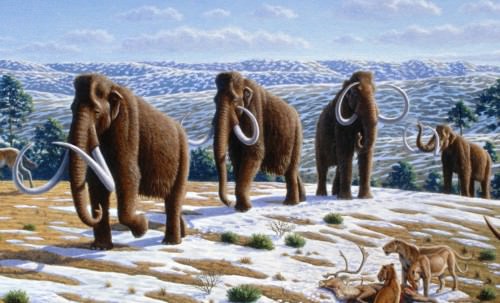
Woolly Mammoths
Straight off the bat, it is important to realise that the variety between hunter-gatherer societies throughout time was so high that no single, all-compassing set of characteristics can be attributed to them. The earliest hunter-gatherers showed very different adaptations to their environment than groups at later points in time, closer to the transition to agriculture. The road towards increasing complexity – something we tend to consider to be the hallmark of 'modernity' - is a difficult yet interesting one to trace. Tools, for instance, became ever more developed and specialised, resulting in a large set of shapes that allowed hunter-gatherers to become better and better at exploiting their environment.
To say anything meaningful about prehistoric hunter-gatherers and their way of life, then, their developments and adaptations throughout time must be highlighted. This will allow us to catch glimpses of how different people may have interacted with their environments in different ways.
OUR GENUS OF HOMO FIRST DEVELOPED WITHIN THE MASSIVE SPACE THAT IS AFRICA, & IT IS THERE THAT HUNTER-GATHERERS FIRST APPEARED.
THE ICE- & STONE AGES
First off, it will be useful to explain some terminology that is used to describe the time during which hunter-gatherers roamed the earth. Geologically, based on the repeating cycles of glaciation (or Ice Ages) during this time, the epoch spanning from roughly 2,6 million years ago to about 12,000 years ago is known as the Pleistocene. Archaeologically, based on stone tool cultures, the Palaeolithic Age falls within the same timeframe as the Pleistocene. The Palaeolithic is further subdivided into the Early- or Lower Palaeolithic (c. 2,6 million years ago - c. 250,000 years ago), which starts with the first recognisable stone tools found to this date; the Middle Palaeolithic (c. 250,000 years ago - c. 30,000 years ago); and the Late- or Upper Palaeolithic (c. 50,000/40,000 - c. 10,000 years ago), ending when the Ice Age ended and agriculture began taking over. The dates overlap here and there because some cultures persisted for longer in certain areas, while others had already developed to the point where they match the characteristics of the next age. It is interesting to stop and consider that although we may feel that our tech savvy, industrialised world has been around for a good while, the Palaeolithic actually makes up about 99% of human technological history.
THE FIRST HUNTER-GATHERERS
Our genus of Homo first developed within the massive space that is Africa, and it is there that hunter-gatherers first appeared.There are a few hotspots where the land clearly provided decently lush living opportunities and where the remains of often several different groups of humans living there at various times have been found. In southern Africa sites such as Swartkrans Cave and Sterkfontein show more than one occupation, although they are a lot younger than sites in eastern Africa, where in or near Ethiopia the earliest known stone tools made by humans – dated to c. 2,6 million years ago – have been found. One of the oldest sites is Lake Turkana in Kenya: it was already home to our presumed ancestors the Australopithecines, to which the famous Lucy belongs, and it continued to be a popular spot for a very long time indeed.
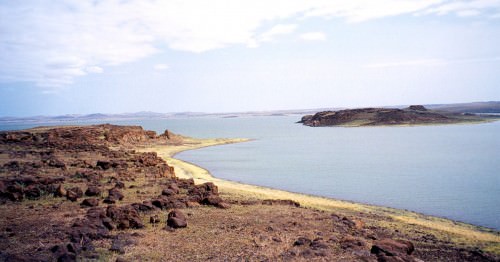
Lake Turkana, Kenya
DEPENDENCY ON THE ENVIRONMENT
From humans' early start in Africa to spilling out across Eurasia and later the rest of the world, all this exploration across vastly different terrains was done while living off the land by hunting and gathering what it had to offer. The amount of food, looking at both flora and fauna, directly impacted the amount of people an environment could feasibly support. If food was abundant, resident groups of hunter-gatherers were more likely to stay in the same place, find ways to effectively store their food, and protect their territory against competing groups. Alternatively, if there was not enough food in a group's direct vicinity, it meant they had to move around and lead more nomadic lifestyles in order to sustain themselves. If this sounds like too much of a piece of cake, imagine that the environment with both its terrain and its weather (think of droughts or huge storms) regularly tried to kill these early humans, with the assistance of animals that had bigger teeth and claws than they did. Luckily, prehistoric societies were made up of groups or bands of a few dozens of people, usually representing several families, that helped each other survive mother nature.
EARLY BANDS OF HOMO ERECTUS WERE LIKELY THE FIRST TO VENTURE OUT INTO NEW WORLDS, NEARLY 2 MILLION YEARS AGO, SPREADING OUT ALL THE WAY TO EURASIA, CHINA, & INDONESIA.
The geographical spread of early man was so vast it is useful to elaborate on this a little. A huge continent such as Africa in itself already hosts all sorts of different landscapes, although in general, some degree of sun and heat would have been part of the deal, but once man spread beyond its borders, a whole new kind of adaptability would have been necessary. Early bands of Homo erectus were likely the first to venture out into new worlds, nearly 2 million years ago, spreading out all the way to Eurasia, China, and Indonesia by c. 1,7 - c. 1,6 million years ago. Europe was most likely not explored until much later;although the Mediterranean shows some tentative human activity before 1 million years ago, the major mountain ranges were not braved by daring travellers (usually thought to have been Homo heidelbergensis ) until around 700,000 years ago. Once they had crossed, they flourished. Neanderthals later evolved from this population and themselves ended up expanding beyond their initial European homes into both the Near East and parts of Central Asia, up to the Altai region in Siberia. By the end of the Middle Palaeolithic, almost the entirety of the Old World had been reached by some group of humans. Insular Asia, Australia and the New World would also all be conquered by humans by the end of the Pleistocene. With our planet covered, there was no environment to which we did not eventually learn to adapt.
Genetic studies are doing their best to come closer to a coherent picture of just how quiet or busy the world must have generally been during the Pleistocene. None has emerged just yet, but a non-genetic estimate of around 500,000 individuals is in agreement with a lot of the recent genetic results. In general, areas would not have been very densely populated. One might wonder what prehistoric man or woman would have to say about our present-day self-proclaimed modernity, which has spawned many massively polluted cities.
SHELTERS
Mostly, these prehistoric hunter-gatherers would have used natural shelters as living space; overhanging cliffs would have provided a place to nestle into to escape the wind and rain, and caves were highly popular as comfortable living spaces could be created within, mostly near the entrance to stay in range of the daylight. However, open sites, more exposed to the elements, have also been found.
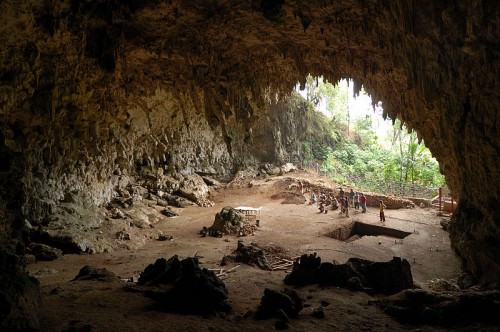
Liang Bua Cave
In the Upper Palaeolithic, humans became ever more inventive and organised, as manmade structures were now created to a much higher degree than before. They offered an alternative to the still very popular cave life, but caves, of course, were not available everywhere, and they were so popular among cave bears and cave lions that it gave them their names. Thus, some societies built huts or tents with wooden supports, or even with mammoth bones forming the structure, which were also illuminated by the light of hearths and had clear architectural features that organised the spaces into designated areas.Materials and tools were moreover much more commonly transported over long distances than they were in the Middle Palaeolithic. However, it is in the persistently useful caves that one of the greatest developments of the Upper Palaeolithic is visible: brilliant cave paintings, such as those at Chauvet Cave or the famous Lascaux Cave, both in present-day France, provide some stunning examples of hunter-gatherer art. Often connected with symbolic thought, it is this that greatly sets these later hunter-gatherers apart and forms part of why they are generally considered to be full-fledged modern humans.
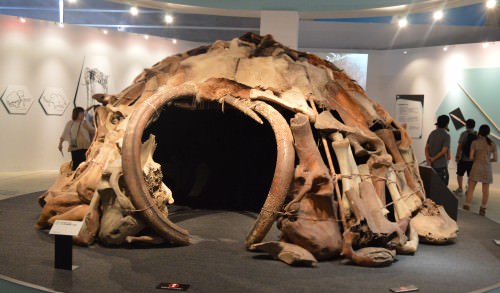
Replica of a Mammoth-bone Structure
FOOD
The exact types of food hunter-gatherers consumed obviously varied depending on the landscape and its resident flora and fauna. Whereas some might specialise in hunting the impressive prehistoric megafauna such as the megaloceros or giant elk, woolly mammoths and woolly rhinoceros, others might focus on trapping small game or on fishing. Although their name implies an active stance, hunter-gatherers most likely scavenged to some degree too.
The earliest humans in Africa were still quite far removed from woolly mammoth -hunting, however, and not just because the time and geographical location do not quite match. They had no sophisticated hunting tools or strategies capable of bringing down quite such enormous prey as of yet, but they did eat meat. After these people had obtained their food, however, they still had to process it. For this, either powerful teeth – for grinding down tough plants with strong molars or biting into non-butchered flesh - or tools that did that for them were needed. Early humans, in general, went down the path towards smaller teeth. Already in species such as Homo rudolfensis the molars were not as large as their ancestors', and later species such as Homo habilis and erectus continued this trend. Teeth size declined, while at the same time brain size grew. They made up for their smaller teeth by developing a stone tool culture, which allowed them to more efficiently exploit their environment than ever before. As such, these humans became more omnivorous - and thus, more versatile and adaptable - by adding more meat to their previously pretty green diet.
Because plant remains do not stand the test of time as well as butchered animal bones do, it is generally hard to determine exactly what our ancestors' veggie habits were like. However, a recent 2016 study gives us a rare glimpse into the plant diet of the people living at Gesher Benot Ya'aqov, Israel, some 780,000 years ago. A stunning 55 kinds of food plants were found there that include seeds, fruits, nuts, vegetables, and roots or tubers. The diversity shows these people had a good knowledge of which edible things could be found in their environment, and in which season, and reflects a varied plant diet. Besides the greens, the diet of this particular hunter-gatherer society also included both meat and fish. Moreover, fire was visibly used in food processing by this group, while cooking and the habitual use of fire seem not to have been widespread until around 500,000 - 400,000 years ago (see below). Whether this site just housed a group of prodigies or whether more general conclusions can be drawn from this is hard to say – it must at the very least be viewed in its geographical and chronological framework.
A bit further along the timescale, Middle Palaeolithic sites show more evidence of local traditions and variation being present.As humans were now well-established both inside and outside of Africa, and had spanned out far north as well as east, population density increased, and that had an effect on the available food. Under the yoke of increased competition, hunters came up with new tactics and began picking targets across a wider range than before. When they were available, however, the prized large- or medium-sized deer, horses, and bovids like bison and gazelle presented too good of an opportunity to pass up.These were definitely the top picks on the hunter-gatherer menu.
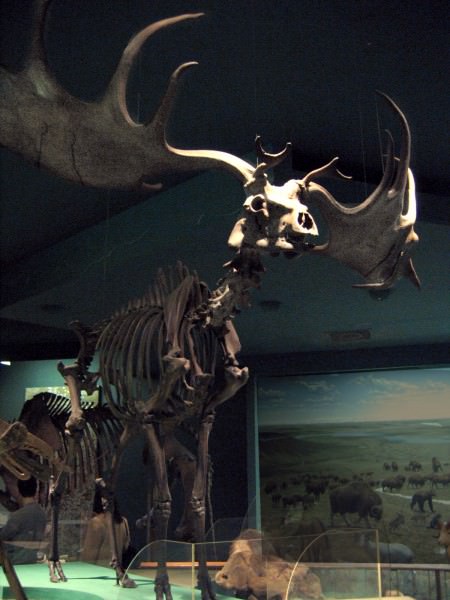
Megaloceros (Giant Elk) Skeleton
'The bigger the animal, the better' is a philosophy that definitely holds up when one is concerned with feeding a whole band of hungry humans leading active lives. For living that dream, the time to be alive was the Late Pleistocene (c. 120,000 - 10,000 years ago), specifically in the main part of Eurasia and stretching all the way into eastern Siberia. There, humans would have found an astonishingly high concentration of megafauna such as mammoths, woolly rhinoceros, Lena horse, and bison, in what has been called the 'Mammoth complex'. Neanderthals, for instance, surely took advantage of this: they are known to have eaten a fair amount of mammoth and rhino meat, besides other meat from mammals such as bison, wild cattle, reindeer, deer, ibex and wild boar. Otherwise, various legumes and grasses, fruits, seeds and nuts generally made up a substantial part of their diet, like it must have done for most hunter-gatherer societies throughout time. The idea that they were mostly meat-eaters (apart from their early beginnings) has long since been overthrown.
TOOLS
The tools used by hunter-gatherers to make their lifestyle possible had their humble beginnings, so far traced back to around 2,6 million years ago, in the Oldowan technology (lasting until c. one million years ago). Simple stone cores were used as choppers, hammerstones, and retouched flake scrapers, in order to both cut the meat off of animals and get to the nutritious marrow inside, or process plants and seeds. This technology was brought out of Africa towards Asia by early waves of Homo erectus that went adventuring.
In Africa, in the meantime, the Acheulean (c. 1,7 million years ago to c. 250,000 years ago) had begun to evolve, which came to Eurasia a bit later on. It saw the development of tools into large bifaces like hand axes, picks and cleavers, enabling Homo erectus, and later on Homo heidelbergensis, to literally get a better grip on the processing of their kills. Although wood of such age generally does not survive, a site in Northern Europe suggests that wooden tools may well have been a part of the daily life of early hunter-gatherers too, presumably stretching all the way into the Middle Palaeolithic.
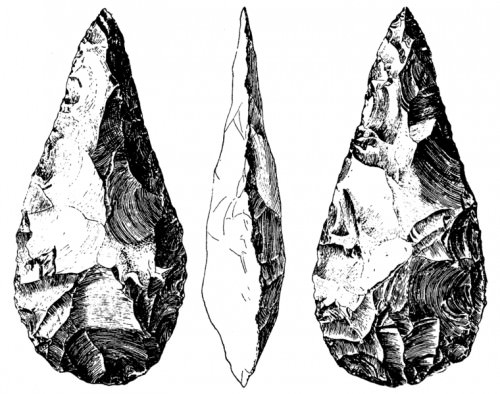
Acheulean Handaxe
Tool use was by now decently established, and the following Middle Palaeolithic saw a fine-tuning; retouched flake tools, such as scrapers, points, and backed knives were made by early forms of Homo sapiens, Neanderthals, and the earliest anatomically modern humans. A huge proliferation then occurred in the Late Palaeolithic, where blade tools were created alongside bone, antler and ivory artefacts, and even such technological feats as spear throwers and bows and arrows began to appear. All in all, around the world, as time went on more and more variability appeared in the stone industries we are uncovering, which not only suggests increasing innovation over time, but also the presence of stronger regional (material) cultures.

Creeping Hyena Spear Thrower of La Madeleine
FIRE AS A CATALYST
Besides the development of tools, another huge change that had an incredible effect on our species is the harnessing of fire.In short, the use of fire meant our ancestors could huddle around it for protection (wild animals in general are not very keen on fire) and warmth, and it allowed them to cook their food - which has an amazing array of benefits. Fire thus plays a central role in human survival and in catalysing the processes of becoming 'human' as we define it.
THE EARLIEST EVIDENCE WE HAVE FOUND SO FAR FOR THE USE OF HOMININ FIRE DATES BACK TO OVER A MILLION YEARS AGO.
The earliest evidence we have found so far for the use of hominin fire dates back to over a million years ago. Around Lake Turkana fire is indicated from around 1,8 million years ago onwards; sites show reddened patches and, for instance, stones altered by heat, but the early African sites show no certain signs of hearths. Indeed, throughout this early stage traces of fire remain very rare on African open sites. Here, fire use may have been more connected to taking advantage of natural fires, such as forest fires or the after-effects of a particularly violent lightning strike, rather than actively creating and maintaining it personally.
It is hard to accurately trace the way in which the use of fire gradually developed throughout time, after its first beginnings.However, by at least 400,000 years ago it is clear that the human bands roving around and setting themselves up in caves not just in Africa, but also the Middle East and Europe, knew and used fire; clear evidence of hearths has been found in Acheulean levels. These people were clearly skilled at maintaining and using fire. Over the next 100,000 years, the habitual and very deliberate use of fire becomes very apparent, like for instance in the Middle East and even at open sites in southern France. It thus became a central part of the hunter-gatherer lifestyle.
Fire had important benefits. Apart from protection and warmth, which would have helped even the earliest, basic fire users to survive, a major advantage that came when the deliberate use of fire began to become more widespread is the ability to cook.Until around 500,000 years ago, cooking seems to have been a rare sight within hunter-gatherers societies. What happened when humans did convert to sizzling their bison steaks and the likes is as follows. Firstly, cooking softens the food, making it easier to chew and digest, which meant people could develop smaller teeth and less long digestive systems, and spend less of their time digesting their food. The traditional hunter-gatherer diet is moreover so hard to ingest and digest in its raw form that cooking, in addition to the calorific benefits, really represented a big change. It also left these early humans' brains free to grow to a larger size than previously possible; large brains are more complex but also more expensive and require high-quality foods. Of course, having larger and more complex brains meant that humans could come up with better ways to maintain and use fire, develop better hunting strategies, and so forth. Thus, the cycle continued.
Fire in general also had an impact on the social side of these hunter-gatherer groups. Fire, with the light it provided, enabled hunter-gatherers to stay active even after sundown, extending their days and leaving more time for social bonding, which is very important especially in larger groups. Modern humans are awake for nearly twice as long as many of their primate cousins.
THE SOCIAL SIDE
This prehistoric lifestyle, with groups sharing and organising a living space, and working towards keeping everyone alive, clearly had some sort of social side to it. Research suggests that a kind of social network structure could well have appeared quite early on in human history, with connections stretching not just to family members but also to non-kin, and that this social aspect may have helped spark (increasingly intensive) cooperation. The hunters at Schöningen, for instance, that are discussed above and belong to a group of Homo heidelbergensis, or at comparable sites such as Boxgrove and Arago, were seemingly so successful they may have been able to get their hands on large amounts of meat. If this was indeed the case, they may have shared or exchanged food with other groups in their neighbourhood, maybe even at established meeting places.
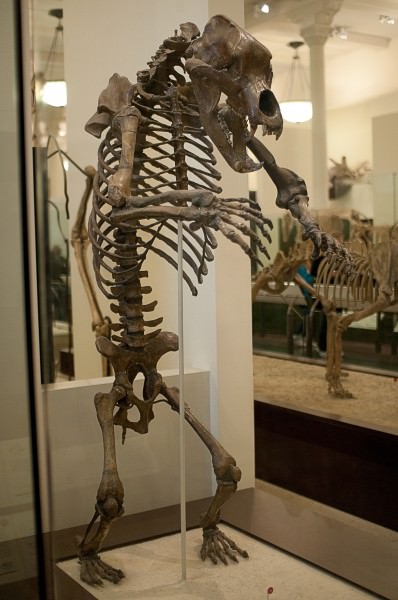
Cave Bear Skeleton
The sheer amount of different Homo species that passes the revue in the space above should already be an indicator of just how diverse hunter-gatherers were: each species had different strengths and weaknesses, and differently structured societies, although with time almost all of these humans walked the road that eventually led to agriculture. The exceptions? Some hunter-gatherer societies persist to this day.
LICENSE
Article based on information obtained from these sources:with permission from the Website Ancient History Encyclopedia
Content is available under License Creative Commons: Attribution-NonCommercial-ShareAlike 3.0 Unported. CC-BY-NC-SA License